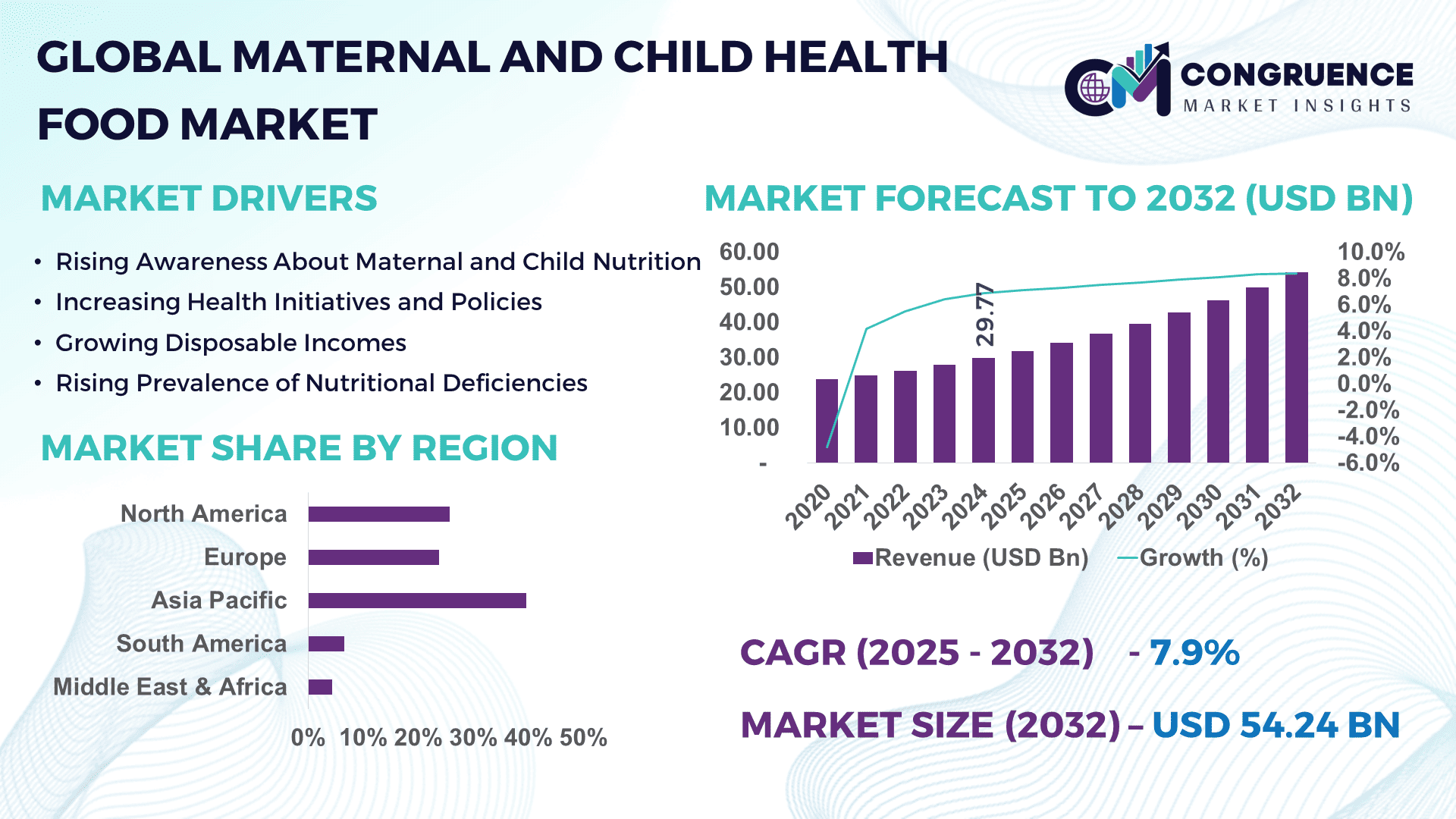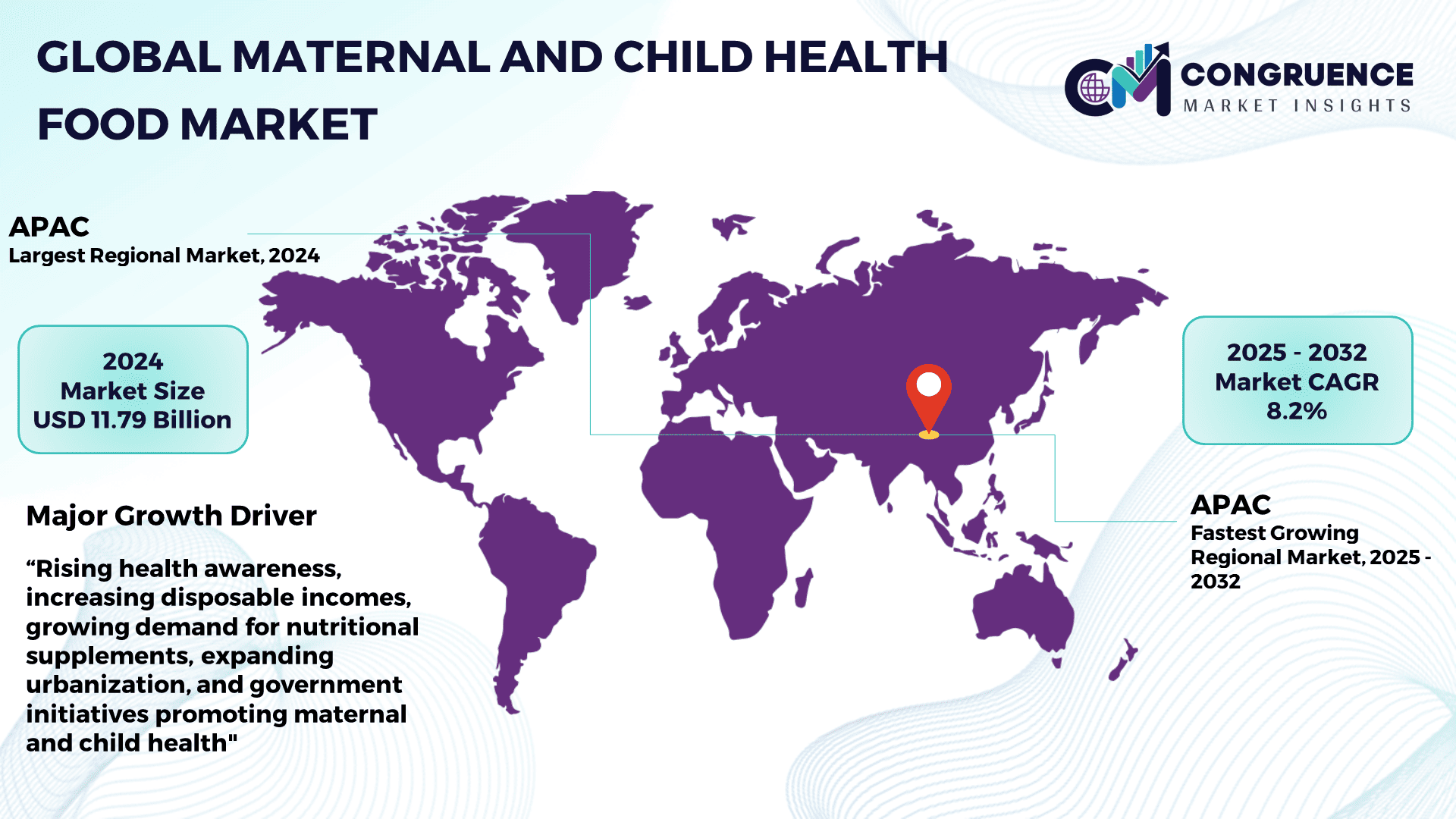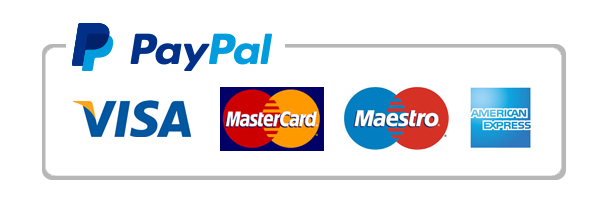Reports
Maternal and Child Health Food Market Report Overview
The Global Maternal and Child Health Food Market was valued at USD 29.77 Billion in 2024 and is anticipated to reach a value of USD 54.24 Billion by 2032 expanding at a CAGR of 7.9% between 2025 and 2032. The primary driving reasons for this market are increased awareness of the importance of nutrition in mother and child health, a greater emphasis on preventative healthcare, and worldwide population growth.

To Learn More About This Report, Request A Free Sample Copy
Maternal and child health is an important part of global healthcare that focuses on the well-being of women and children during pregnancy, delivery, and early childhood. Nutritional support is essential for optimal growth, disease prevention, and long-term health outcomes. The maternal and child health food market includes a variety of items tailored to the nutritional needs of pregnant women, breastfeeding moms, newborns, and toddlers. As consumers become more aware of the benefits of nutritional supplements, there is a growing need for high-quality, specialized mother and child health foods. Urbanization, the emergence of nuclear families, and growing worries about child health all contribute to increased demand for these products. Furthermore, rising disposable incomes in developing countries and an increasing tendency toward fortified foods are likely to drive market expansion. Governments and healthcare organizations are working to enhance maternal and child health around the world, which is helping to grow the market for maternity and child health foods.
How AI is Transforming Maternal and Child Health Food Market
Artificial intelligence (AI) is transforming the maternal and child health food market by accelerating product development, increasing consumer involvement, and streamlining supply chains. AI-powered data analytics helps businesses better understand consumer preferences and nutritional requirements. Manufacturers can use predictive analysis to adjust products to the individual needs of distinct maternal and child groups, ensuring that the proper nutritional balance is attained at various periods of maternity and child development. Furthermore, AI-driven research and development (R&D) is hastening the development of new goods, such as personalized nutrition solutions tailored to specific health problems and genetic profiles.
AI also helps businesses enhance their supply chain management by lowering costs and assuring timely product availability. By analyzing historical data and market patterns, AI systems can optimize inventory management, estimate demand, and eliminate waste, ensuring that products reach customers when they are most needed. Additionally, AI-powered chatbots and virtual assistants support women in accessing professional advice and product recommendations, making it easier for them to select the best nutritional supplements for themselves and their children. The integration of AI across several market segments is predicted to considerably improve efficiency and innovation in the maternal and child health food market.
Maternal and Child Health Food Market Major Driving Forces
· Rising Awareness: Increasing awareness of the importance of maternal and child nutrition is a major driving force in the maternal and child health food market. With a rising emphasis on early-life nutrition, both consumers and healthcare providers are focusing on getting enough vitamins and minerals during pregnancy and infancy.
· Health Initiatives and Policies: Government and international healthcare organizations' initiatives to promote maternal and child health are also driving market growth. Campaigns aiming at reducing malnutrition and improving maternal health outcomes promote the consumption of fortified and specialized foods.
· Growing Disposable Incomes: Rising disposable incomes in emerging countries have resulted in an increase in demand for premium, organic, and nutritionally fortified food products. This shift in customer choices is projected to accelerate market growth.
· Rising Prevalence of Nutritional Deficiencies: The rising prevalence of malnutrition and nutritional inadequacies, particularly in developing nations, is driving demand for fortified maternal and child health meals. Governments and health organizations are increasingly emphasizing the need of good nutrition for pregnant women and young children in order to address stunting, anemia, and other health issues. This is driving the maternal and child health food industry, as more efforts are being made to ensure the availability of nutritionally enhanced food products that address the special needs of moms and children.
Maternal and Child Health Food Market Key Opportunities
· Personalized Nutrition Solutions: As AI and data analytics advance, there is an opportunity for companies in the maternal and child health food market to create personalized nutrition solutions based on individual health profiles. This trend is likely to appeal to consumers looking for personalized approaches to mother and child health.
· Expansion into Emerging Markets: The rising demand for maternal and child health goods in emerging nations, particularly Asia Pacific and Africa, represents a huge growth opportunity. As these countries undergo increasing urbanization and increased healthcare awareness, there is a growing demand for nutritional supplements and fortified foods.
· Sustainability Focus: As consumers become more environmentally sensitive, there are potential for brands to offer sustainable, organic, and eco-friendly maternal and child health food products. Companies who can align with these principles are likely to thrive in this growing market.
Maternal and Child Health Food Market Key Trends
· Consumers are increasingly seeking fortified and organic mother and child health food items, which is fueling market expansion. These nutrient-dense products appeal to health-conscious parents and expectant moms, since they promote optimal development and avoid deficits.
· A growing trend in the maternal and child health food market is related to the emergence of e-commerce platforms that has changed the way people buy maternal and child health foods. Online retail provides convenience and a more diverse product assortment, resulting in greater sales in this channel.
· The trend toward preventive healthcare encourages customers to invest in nutritional supplements that can improve general health throughout pregnancy and childhood. This emphasis on long-term health is a significant trend influencing the future of the mother and child health food sector.
Region-wise Market Insights
Asia Pacific accounted for the largest market share at 39.6% in 2024 moreover, Asia Pacific is also expected to register the fastest growth, expanding at a CAGR of 8.2% between 2025 and 2032.

To Learn More About This Report, Request A Free Sample Copy
In 2024, the Asia Pacific region held the largest share of the global maternal and child health food market. From 2025 to 2032, the region is also predicted to expand at the fastest CAGR of 8.2%. Rising birth rates, increased healthcare knowledge, and a burgeoning middle class are among the factors fueling Asia Pacific growth. Countries such as China, India, and Japan are investing in healthcare facilities and nutritional products, making the area a hotbed of market growth.
· In September 2024, Perrigo partnered with Good Start and Dr. Brown's brands to launch a new infant formula portfolio. This collaboration aims to provide high-quality nutrition options for infants, leveraging the strengths of both brands in formula production and baby products. The partnership introduces various products designed to support infant growth and development while addressing common feeding challenges.
North America is another large market, driven by strong healthcare standards and the presence of industry leaders. The region's demand for organic and premium maternal and child health foods is projected to remain strong. Europe, with its strong food quality and safety rules, represents a steady market, particularly in Germany and the United Kingdom.
The Middle East and Africa, as well as South America, are rising areas where increased healthcare access and government initiatives are likely to drive market expansion throughout the projection period.
Recent Developments
· In October 2023, FrieslandCampina launched its "Step Up Nutrition" portfolio, aimed at supporting the nutritional needs of children as they grow. The portfolio focuses on products designed to meet the evolving nutritional requirements of different age groups, promoting healthy growth and development. This initiative aligns with FrieslandCampina's commitment to providing accessible, high-quality nutrition for children across various markets.
· In November 2022, Plum Organics and 2020 Mom partnered to drive change in mental health care for mothers. The collaboration focuses on raising awareness and supporting efforts to address the mental health challenges faced by moms, advocating for better access to care and resources. Plum Organics aims to leverage its platform to shed light on maternal mental health issues, while 2020 Mom brings its expertise in maternal mental health advocacy.
· In January 2021, Baby Gourmet, a Canadian organic baby food brand, was acquired by Hero Group. This acquisition positioned Baby Gourmet for U.S. market expansion and new product development. The Hero Group, known for its infant nutrition and natural products, aimed to leverage Baby Gourmet’s strong market presence and extend its reach beyond Canada.
Market Competition Landscape
The global maternal and child health food market is dominated by established companies and growing regional brands. Major corporations prioritize extending their product portfolios through strategic alliances, mergers and acquisitions, and R&D investments in product innovation. The increased demand for organic and tailored nutrition products has an impact on the competitive landscape as well. Companies that invest in sustainability and new product development are expected to keep their competitive advantage.
Key players in the global maternal and child health food market implement various organic and inorganic strategies to strengthen and improve their market positioning. Prominent players in the market include:
· Nestlé S.A.
· Abbott Laboratories
· Danone S.A.
· Mead Johnson Nutrition Company (Reckitt Benckiser)
· The Kraft Heinz Company
· Perrigo Company plc
· FrieslandCampina
· Hero Group
· Bellamy's Organic
· Plum Organics
· Sprout Organic Foods, Inc.
· HiPP GmbH & Co. Vertrieb KG
· Baby Gourmet Foods Inc.
· Hain Celestial Group
|
Report Attribute/Metric |
Details |
|
Market Revenue in 2024 |
USD 29.77 Billion |
|
Market Revenue in 2032 |
USD 54.24 Billion |
|
CAGR (2025 – 2032) |
7.9% |
|
Base Year |
2024 |
|
Forecast Period |
2025 – 2032 |
|
Historical Data |
2020 to 2024 |
|
Forecast Unit |
Value (US$ Bn) |
|
Key Report Deliverable |
Revenue Forecast, Growth Trends, Market Dynamics, Segmental Overview, Regional and Country-wise Analysis, Competition Landscape |
|
Segments Covered |
· By Type (Infant Formula, Follow-on Formula, Prenatal Nutrition, Lactation Supplements, and Toddler Nutrition) · By Frequency (Low Frequency and High Frequency) · By End-Use (Infants, Toddlers, Pregnant Women, and Lactating Mothers) · By Application (Hospitals, Pharmacies, Online Retail, and Specialty Stores) |
|
Geographies Covered |
North America: U.S., Canada and Mexico Europe: Germany, France, U.K., Italy, Spain, and Rest of Europe Asia Pacific: China, India, Japan, South Korea, Southeast Asia, and Rest of Asia Pacific South America: Brazil, Argentina, and Rest of Latin America Middle East & Africa: GCC Countries, South Africa, and Rest of Middle East & Africa |
|
Key Players Analyzed |
Nestlé S.A., Abbott Laboratories, Danone S.A., Mead Johnson Nutrition Company (Reckitt Benckiser), The Kraft Heinz Company, Perrigo Company plc, FrieslandCampina, Hero Group, Bellamy's Organic, Plum Organics, Sprout Organic Foods, Inc., HiPP GmbH & Co. Vertrieb KG, Baby Gourmet Foods Inc., Hain Celestial Group |
|
Customization & Pricing |
Available on Request (10% Customization is Free) |
